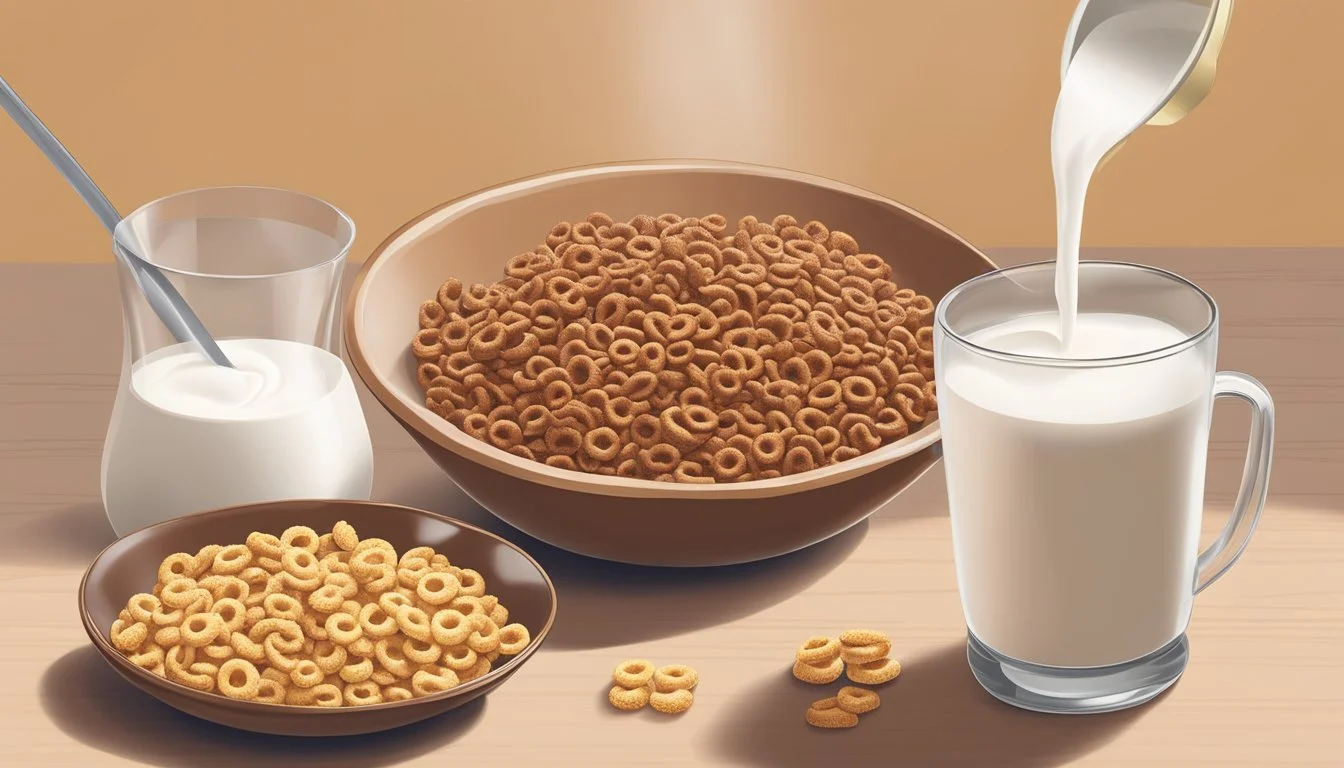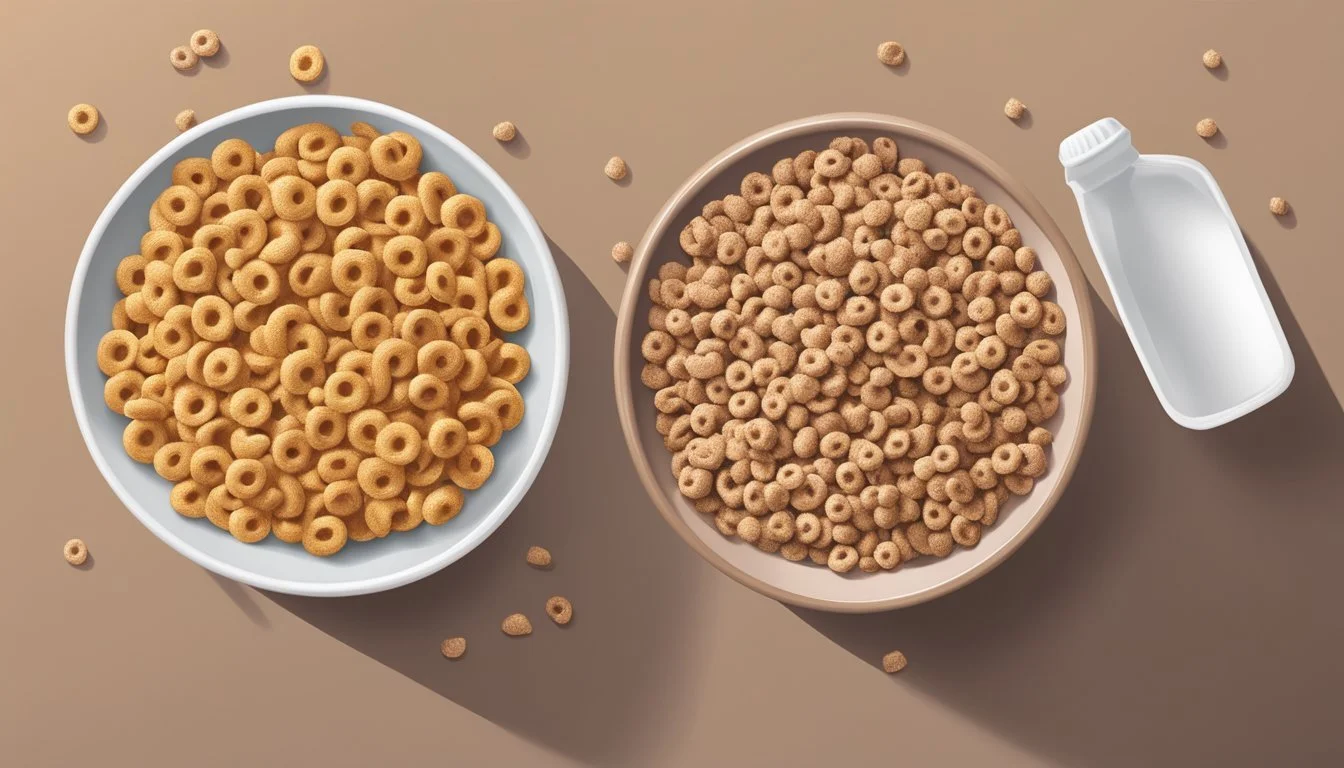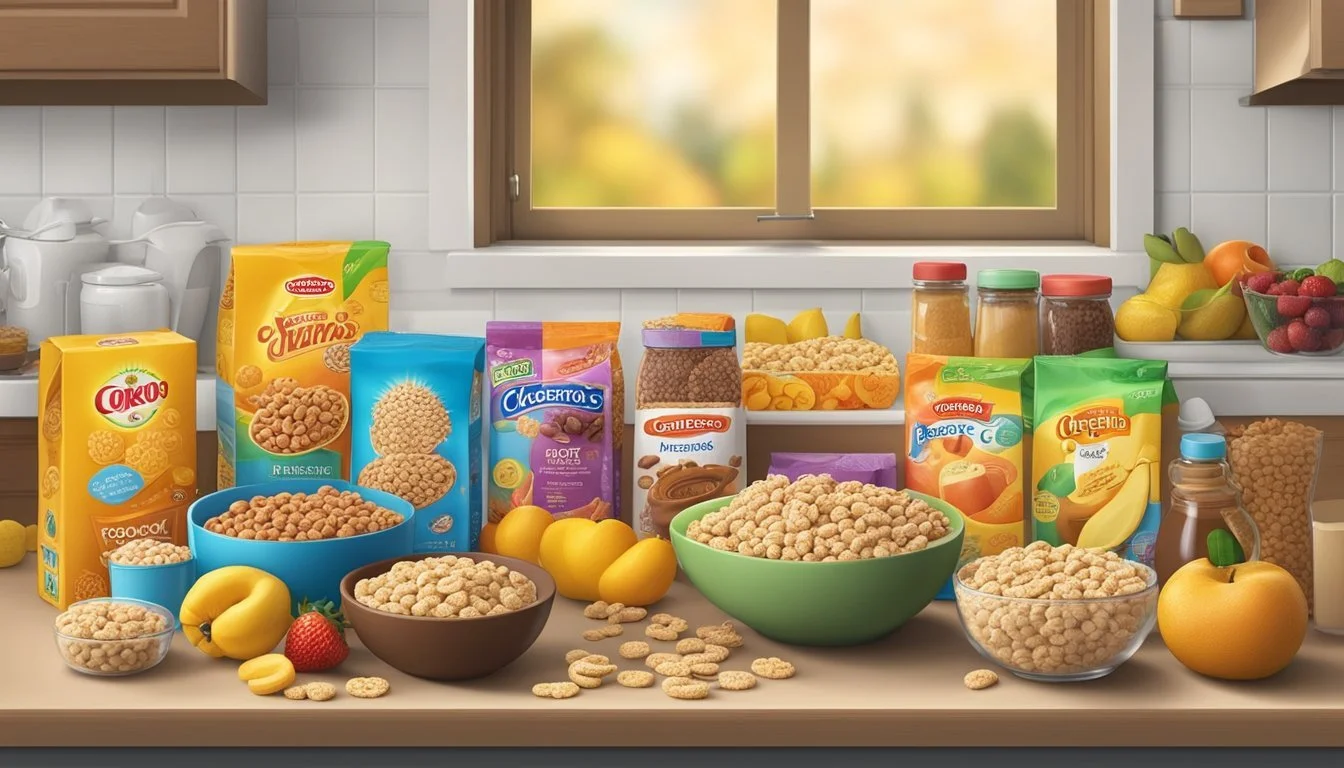Cheerios vs Cocoa Krispies
A Comparative Analysis of Nutritional Value and Flavor
This Article is Part of Our Breakfast Cereal Guide with Details on Cheerios Nutrition and Cocoa Krispies Nutrition
For those who kickstart their day with a bowl of breakfast cereal, choosing between Cheerios and Cocoa Krispies can be a daily dilemma. Cheerios, the wholesome oat cereal from General Mills, offer a nutrient-rich start. General Mills Cheerios boast a higher content of Iron, Zinc, and Fiber compared to Cocoa Krispies, making them a healthier pick for those focused on nutrition.
On the other hand, Cocoa Krispies, known for their crisp texture and chocolaty flavor, cater to a different palate. While they may not match the nutritional profile of Cheerios, their unique taste and fun snap, crackle, and pop can make breakfast enjoyable for children and adults alike. Their distinct chocolate sweetness is an appealing factor for many.
Ultimately, the choice between Cheerios and Cocoa Krispies hinges on your priorities. For those seeking a nutritious, fiber-rich option, Cheerios is the clear winner. If flavor and a bit of morning fun are your primary concerns, Cocoa Krispies may just be the answer.
Historical Background
Cheerios and Cocoa Krispies, two iconic breakfast cereals, have fascinating origins tied to their respective manufacturers, General Mills and Kellogg's.
Origin of Cheerios
Cheerios emerged in 1941, initially named "Cheerioats." General Mills created Cheerios as a healthier alternative to high-sugar cereals. The O-shaped cereal quickly became popular due to its wholesome ingredients and appealing shape.
By 1945, the name was changed to Cheerios to avoid trademarks issues. They gained a mass following with prominent marketing campaigns focusing on health benefits. Cheerios have since expanded their range to include varieties like Honey Nut Cheerios, introduced in 1979.
Creation of Cocoa Krispies
Cocoa Krispies, a product of Kellogg's, debuted in 1958. Known for its chocolate flavor and engaging "Snap, Crackle, and Pop" characters, Cocoa Krispies found a niche among children.
The cereal was modeled after Rice Krispies, but with added cocoa for a distinct taste. Over the years, Cocoa Krispies have maintained popularity, adapting their marketing strategies to appeal to new generations. Kellogg's has periodically introduced new flavors and variations.
Both Cheerios and Cocoa Krispies have left significant marks in the breakfast cereal market, each representing their brand's innovative approach to cereal production.
Nutritional Comparison
Cheerios and Cocoa Krispies each offer unique nutritional benefits, making them appealing in different ways. It is important to consider their macronutrient content as well as their vitamin and mineral composition to determine which cereal fits better into one's diet.
Macronutrient Content
Cheerios are a low-calorie option, with a serving containing around 105 calories. They are notably high in fiber, providing about 3 grams per serving. This makes them a more filling choice.
Cocoa Krispies, on the other hand, have a higher calorie count per serving, typically around 120 calories. They contain less fiber, with only about 1 gram per serving, which may result in less satiety.
Both cereals are relatively low in protein, but Cheerios provide a bit more at approximately 3 grams per serving compared to Cocoa Krispies' 2 grams. When evaluating sugar content, Cocoa Krispies are higher with around 9 grams per serving, compared to Cheerios which have about 1 gram.
Vitamins and Minerals
Cheerios are enriched with several essential vitamins and minerals. They provide significant amounts of iron, covering over 200% of the daily required intake. This makes them especially beneficial for individuals needing increased iron intake. They also supply notable amounts of zinc, manganese, folate, and vitamin B12.
Cocoa Krispies offer higher levels of vitamin B2 (riboflavin) and vitamin E. These vitamins are crucial for various bodily functions, including energy production and antioxidant protection.
While both cereals are fortified, Cheerios have a clear edge in providing a comprehensive range of vitamins and minerals. For instance, Cheerios contain higher amounts of vitamins such as B6 and B1, and minerals like phosphorus.
Healthier Choice
When considering health benefits, Cheerios emerge as a healthier option due to their high fiber content and lower sugar levels. These attributes help in managing blood sugar levels and promoting digestive health. Additionally, the richer profile of vitamins and minerals in Cheerios, particularly iron and B vitamins, supports overall well-being.
Cocoa Krispies, while tasty, are significantly higher in sugar and calories. This makes them less ideal for those monitoring their caloric intake or trying to limit sugar consumption. The presence of real chocolate in Cocoa Krispies adds to their flavor but contributes to their higher sugar content.
Choosing the best cereal ultimately depends on dietary needs and health goals.
Taste and Texture Profile
Cheerios and Cocoa Krispies offer distinct taste and texture profiles that cater to different breakfast preferences. The following analysis breaks down the flavor variations and textural experiences that each cereal provides.
Flavor Varieties
Cheerios are known for their mild and slightly sweet taste, appealing to those who enjoy a more subtle breakfast cereal. The original flavor has a hint of oat, making it versatile for both children and adults. They also come in multiple varieties, including honey nut, apple cinnamon, and multigrain, each adding a unique twist to the base oat flavor.
Cocoa Krispies, on the other hand, deliver a richer chocolate flavor, making them a favorite for chocolate cereal enthusiasts. The chocolate coating provides a sweet, indulgent experience, especially when combined with milk. The flavor is pronounced enough to stand out in taste tests, particularly appealing to those with a sweet tooth.
Texture Experience
Cheerios feature a sturdy, round shape that holds up well in milk, retaining a pleasant crunch even after several minutes. This texture makes them satisfying to eat both with milk and as a dry snack. The firmness of the oat-based rings contributes to a consistently enjoyable eating experience.
Cocoa Krispies shine in their light, crispy texture. Made from puffed rice, they create a more delicate bite compared to Cheerios. When soaked in milk, they quickly develop a softer texture, transforming the cereal into a creamy, chocolatey treat. This fast-absorbing quality enhances their appeal for those who prefer a lighter cereal experience.
In summary, Cheerios and Cocoa Krispies bring different taste and texture profiles to the table, catering to various preferences in breakfast cereals.
Cereal Composition
Cheerios and Cocoa Krispies differ significantly in their grain types, additives, and sweeteners. These variations affect their nutritional profiles and appeal to different consumer preferences.
Grain Types
Cheerios primarily use whole grain oats as their main ingredient, making them rich in fiber and essential nutrients. Oats are known for their heart health benefits and are a good source of beta-glucan, a type of soluble fiber.
Cocoa Krispies, on the other hand, rely heavily on rice. Rice offers a light and crisp texture but contains less fiber than oats. While rice does not provide the same level of complex nutrients as whole grains, it is easier to digest.
Using whole grains in Cheerios contributes to a more balanced nutritional profile. In contrast, the rice in Cocoa Krispies lends itself to a lighter but less nutrient-dense cereal option.
Additives and Sweeteners
Cheerios are relatively low in additives and sweeteners. Their simple ingredient list includes whole grain oats, corn starch, and a small amount of sugar and salt. There are no artificial flavors, making Cheerios a suitable choice for those looking to avoid added chemicals in their diet.
Conversely, Cocoa Krispies contain several sweeteners and additives. High fructose corn syrup is a key ingredient, contributing to its sweeter taste. Additionally, artificial flavors are used to enhance the cocoa taste, while various preservatives ensure a longer shelf life.
The simplicity of Cheerios' composition generally makes it a healthier option. The more complex mix of additives and sweeteners in Cocoa Krispies provides a more flavorful experience but at the cost of higher sugar and artificial ingredients.
Environmental and Health Impacts
When comparing Cheerios and Cocoa Krispies, understanding their environmental and health effects provides a more comprehensive picture. This includes analyzing the sustainability of their ingredients and how they stack up according to healthy eating guidelines.
Sustainability of Ingredients
Cheerios primarily use whole grain oats, which are known for their minimal environmental impact. Oats require less water and synthetic fertilizers compared to other grains, making them a more sustainable choice.
Cocoa Krispies rely on rice and cocoa. Rice cultivation can be water-intensive and often involves heavy pesticide use. Cocoa production has other challenges, including deforestation and the use of child labor in some regions.
Cheerios also include fewer artificial preservatives like BHT (Butylated Hydroxytoluene), enhancing their eco-friendly profile. Cocoa Krispies, while popular, face scrutiny for their environmental footprint due to intensive agricultural practices.
Healthy Eating Guidelines
Cheerios are lower in sugar and sodium, which aligns well with healthy eating guidelines. Per serving, they contain 1 gram of sugar and 140 milligrams of sodium, making them a favorable option for those monitoring their sugar intake.
Cocoa Krispies, on the other hand, have higher sugar content, with 12 grams per serving, contributing significantly to daily sugar limits. They also offer essential vitamins such as Vitamin B2 and Vitamin E but lack the high fiber content found in Cheerios.
Both cereals provide essential nutrients but differ in their health profiles. Cheerios' higher fiber content and lower sugar levels make them a better choice for heart health and managing blood sugar levels.
Versatility in Recipes
Both Cheerios and Cocoa Krispies offer diverse uses in various recipes, with each cereal bringing unique qualities to snacking and cooking as well as pairing with different beverages.
Snacking and Cooking
Cheerios are commonly used in no-bake snack recipes. For instance, straightforward Cheerio bars require just butter, marshmallows, and the cereal. This simplicity makes them a favorite for quick, fun-to-make treats.
Cocoa Krispies, with their strong chocolate flavor, are perfect for creating more indulgent snacks. For example, they can be incorporated into chocolate clusters by melting chocolate and mixing it with the cereal. This makes for a rich, crunchy snack that is simple yet satisfying.
Both cereals can be included in more complex recipes. Cheerios' neutral taste fits well in savory dishes like Cheerio-crusted chicken tenders, while Cocoa Krispies can enhance desserts like chocolate-covered marshmallow pops.
Beverage Pairings
Cheerios pair well with a range of beverages due to their mild flavor. Traditional cow’s milk, almond milk, and soy milk are ideal choices. This versatility allows Cheerios to adapt seamlessly, enhancing the taste of the milk without overwhelming it.
Cocoa Krispies create a distinct chocolate milk once the cereal has soaked, providing an extra treat when finished. This cereal also pairs perfectly with regular milk, but for an even richer experience, chocolate milk can be used, amplifying the chocolatey goodness.
In snack recipes, beverages like coffee or hot cocoa can turn simple treats into decadent accompaniments, with Cocoa Krispies particularly enhancing these pairings thanks to their chocolate content.
Brand Competition
Cheerios and Cocoa Krispies, both leading contenders in the cereal market, offer unique tastes and nutritional profiles. Understanding how they measure against other cereals and consumer loyalty can provide a clearer picture of their market standing.
Comparison to Other Cereals
General Mills Cheerios is a staple in the breakfast category, known for its simple ingredients and whole grain oats. It boasts low calorie and low sodium levels, appealing to health-conscious consumers.
By contrast, Kellogg's Cocoa Krispies offers a chocolatey taste that appeals primarily to those with a sweet tooth. With higher sugar content, it competes directly with other sweet cereals like Fruity Pebbles and Golden Grahams. While Cheerios aligns itself with the likes of Whole Grain Total and Special K, Cocoa Krispies finds rivals in Lucky Charms and Cookie Crisp.
Another key difference is their marketing approach. Cheerios is often promoted as a heart-healthy choice, while Cocoa Krispies targets younger demographics with engaging packaging and flavors.
Consumer Loyalty and Switching
Cheerios has developed a loyal customer base due to its health benefits and consistent quality. Parents often choose Cheerios for their children due to its simple ingredients and lack of artificial flavors. It's a go-to choice for those prioritizing long-term health.
In contrast, Cocoa Krispies enjoys loyalty from consumers seeking a more indulgent breakfast experience. Its rich chocolate flavor creates a strong following among kids and adults who prioritize taste over nutrition.
Switching between these two brands often depends on lifestyle changes. For instance, a person may switch to Cheerios when adopting a healthier diet. Conversely, someone might choose Cocoa Krispies for a nostalgic or taste-driven reason.
Furthermore, both brands face challenges from emerging cereals that blend health and taste. Other Brands offering innovative flavors and nutritional benefits continuously test consumer loyalty, pushing Cheerios and Cocoa Krispies to adapt and enhance their offerings.






